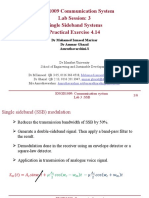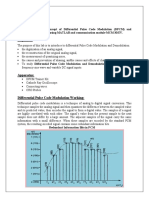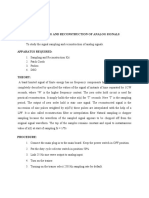Expt2 PAM
Uploaded by
Niyaz Ahmed JohanExpt2 PAM
Uploaded by
Niyaz Ahmed JohanAmerican International University Bangladesh Faculty of Engineering EEE 4106: Telecommunication Engineering Laboratory
Experiment 2: Sampling and Signal Reconstruction
Objectives To understand how a wave can be sampled To investigate the minimum sampling frequency of an idle system To identify the principles of the operation of a PAM system Equipments Oscilloscope Modicom 1 board Power supplies (+12 v, 0 V, -12v, +5v, 0v) Introduction Sampling is a method used in pulse modulation to identify the intelligence signal by a sequence of pulses that represents the intelligence signal by a sequence of pulses that represents the intelligence at a particular time The sampling principle states that the intelligence can be reconstructed by filtering when the sampling signal frequency or sampling (Fs) is greater than twice the maximum intelligence signal frequency (Fm). The Nyquist rate is a condition that occurs when the sampling signal frequency is equal to twice the maximum intelligence signal frequency (Fs = 2Fm, where is the sampling signal frequency and Fm is the maximum frequency of the intelligence signal). The frequency response of the low-pass filter must be capable of passing the maximum intelligence signal to reconstruct the intelligence signal frequency while rejecting side band frequencies of the sampling signal to reconstruct the intelligence free of distortion.
The MODICOM 1 Board Blocks The board can be considered as five separate blocks as shown in Figure 2.1: Power Input Sampling Control Logic Sampling Circuits 2nd Order Low Pass Filter 4th Order Low Pass Filter
Page 1 of 4
Fig 2.1 Modicom 1 Board blocks Power input The figure 2.2 shows the electrical input connections necessary to power the module. The LJ Technical Systems' "I.C. Power 60" or "System Power 90" are the recommended power supplies.
Fig 2.2 Power input Sampling control logic This circuitry as shown in Figure 2.3 generates the timing and control signals that sample the input waveform, and also creates a sinusoidal 1kHz signal for use during the
Fig 2.3 Sampling control logic
Page 2 of 4
It is recommended that this signal is used for most of the experiments, as you will find that it is difficult to synchronize more than one oscilloscope trace when the input comes from an external source. Sampling circuits The signal at the ANALOG INPUT socket is sampled at a rate, and for duration, which depends on the applied sampling control signal as shown in the Figure 2.4.
Figure 2.4 Sampling circuits
Second order and Fourth order low pass filter This is a filter having a 3.4kHz bandwidth as shown in the Figure 2.5. Similar to the Second Order Low Pass Filter, Fourth order has a steeper cut off gradient represented by the graph on the board.
Figure 2.5 Second order and Fourth order low pass filter
Page 3 of 4
Procedure 1. Observe how a signal can be sampled. 2. Obtain a variety of sampling frequencies from the MODICOM 1 board. 3. Demonstrate that the pulse duration of the sampling control signal can be varied. 4. Calculate the frequency spectrum of a pulse amplitude modulated signal. 5. Investigate the minimum sampling frequency of an ideal system. 6. Record the effects of changing the sampling rate in a PAM system. 7. Observe the effects of changing the width of the samples. 8. Recognize the differences between second order and fourth order filters. 9. Compares the performance of sample amplifiers and sample & hold amplifiers.
Discussions 1) Draw all of the waveforms at various stages with your interpretation. 2) Draw the frequency spectrum of a sine wave (~1kHz) with sampling frequency 4kHz before and after the sampling process. 3) What is the relationship between the duty cycle and the reconstructed signal? 4) Describe the required characteristics of the low pass filter, and the sampling frequency to reconstruct the intelligence signal.
Page 4 of 4
Prepared by Farhadur Arifin
You might also like
- ENGD1009 Communication System Lab Session: 7 Digital Communication Chapter 3: The MODICOM 3 PCM Receiver100% (1)ENGD1009 Communication System Lab Session: 7 Digital Communication Chapter 3: The MODICOM 3 PCM Receiver9 pages
- 9 Ways BMC Helix Itsm Beats The Competition 2No ratings yet9 Ways BMC Helix Itsm Beats The Competition 213 pages
- ENGD1009 Communication System Lab Session: 6 Digital Communication Chapter 2: The MODICOM 3 PCM TransmitterNo ratings yetENGD1009 Communication System Lab Session: 6 Digital Communication Chapter 2: The MODICOM 3 PCM Transmitter13 pages
- MODICOM 3 - 1 Board Overview - LJ CreateNo ratings yetMODICOM 3 - 1 Board Overview - LJ Create6 pages
- © 2007 Emona Instruments Experiment 15 - PCM Decoding 15-2No ratings yet© 2007 Emona Instruments Experiment 15 - PCM Decoding 15-215 pages
- Introduction To Practical Exercises Using MODICOM 2 ... - LJ Create PDFNo ratings yetIntroduction To Practical Exercises Using MODICOM 2 ... - LJ Create PDF8 pages
- MODICOM 3 Setup Procedures - LJ Create PDFNo ratings yetMODICOM 3 Setup Procedures - LJ Create PDF4 pages
- ENGD1009 Communication System Lab Session: 4 DSB Transmitter & Receiver Practical Exercise 3.19No ratings yetENGD1009 Communication System Lab Session: 4 DSB Transmitter & Receiver Practical Exercise 3.199 pages
- ENGD1009 Communication System Lab Session: 1 Introduction To ANACOM BoardNo ratings yetENGD1009 Communication System Lab Session: 1 Introduction To ANACOM Board9 pages
- ENGD1009 Communication System Lab Session: 8 Further Digital Communication Chapter 6: Amplitude Shift Keying (ASK) Practical Exercise 6.3 & 6.4No ratings yetENGD1009 Communication System Lab Session: 8 Further Digital Communication Chapter 6: Amplitude Shift Keying (ASK) Practical Exercise 6.3 & 6.413 pages
- ENGD1009 Communication System Lab Session: 5 Frequency Modulation Practical Exercise 7.15 & 7.16No ratings yetENGD1009 Communication System Lab Session: 5 Frequency Modulation Practical Exercise 7.15 & 7.1611 pages
- ENGD1009 Communication System Lab Session: 2 The Double Sideband AM WaveformNo ratings yetENGD1009 Communication System Lab Session: 2 The Double Sideband AM Waveform5 pages
- ENGD1009 Communication System Lab Session: 3 Single Sideband Systems Practical Exercise 4.14No ratings yetENGD1009 Communication System Lab Session: 3 Single Sideband Systems Practical Exercise 4.146 pages
- Time Division Multiplexing & DemultiplexingNo ratings yetTime Division Multiplexing & Demultiplexing11 pages
- ELE 3203 Communication Systems: Student Name ID NumberNo ratings yetELE 3203 Communication Systems: Student Name ID Number16 pages
- Amplitude Shift Keying Modulator DemodulatorNo ratings yetAmplitude Shift Keying Modulator Demodulator10 pages
- Analog Circuits and Systems: Prof. K Radhakrishna Rao Introduction To Sensors, Signals and SystemsNo ratings yetAnalog Circuits and Systems: Prof. K Radhakrishna Rao Introduction To Sensors, Signals and Systems35 pages
- PAM, PPM, PWM Modulation and Demodulation Trainer ST2110 Learning100% (2)PAM, PPM, PWM Modulation and Demodulation Trainer ST2110 Learning67 pages
- Expt#5 Phase Modulation (PM) Generation and DemodulationNo ratings yetExpt#5 Phase Modulation (PM) Generation and Demodulation5 pages
- EXPT 04 - 4-PSK Modulation & DemodulationNo ratings yetEXPT 04 - 4-PSK Modulation & Demodulation6 pages
- Analog Communication Lab Final Doc SRN PDFNo ratings yetAnalog Communication Lab Final Doc SRN PDF90 pages
- EC2307-New Digital Communication Lab Manual Odd 2011No ratings yetEC2307-New Digital Communication Lab Manual Odd 201153 pages
- Laboratory Manual On Analog Communication Techniques (2003)100% (1)Laboratory Manual On Analog Communication Techniques (2003)31 pages
- Laboratory Manual: Analogue and Digital Communication LabNo ratings yetLaboratory Manual: Analogue and Digital Communication Lab16 pages
- Experiment No: 1 Modulation and Demodulation of PAM, PWM, PPM AimNo ratings yetExperiment No: 1 Modulation and Demodulation of PAM, PWM, PPM Aim5 pages
- Amplitude Shift Keying (ASK) Modulation MATLAB Simulation: C Amp. Sin (2 Pi FC T) % For Generating Carrier Sine WaveNo ratings yetAmplitude Shift Keying (ASK) Modulation MATLAB Simulation: C Amp. Sin (2 Pi FC T) % For Generating Carrier Sine Wave6 pages
- Third Year: Practical Work Book For The Course EE-394 Communication SystemNo ratings yetThird Year: Practical Work Book For The Course EE-394 Communication System22 pages
- Sampling Theorem Verification: Electronics & Communication Engineering100% (1)Sampling Theorem Verification: Electronics & Communication Engineering0 pages
- Oil and Petrochemical Overview - Solutions For Your ... - Spirax SarcoNo ratings yetOil and Petrochemical Overview - Solutions For Your ... - Spirax Sarco12 pages
- Phrasal Verbs About Clothes and FashionNo ratings yetPhrasal Verbs About Clothes and Fashion14 pages
- ELYM 115 2nd Opp Examination MC-2022-09-21 TTNo ratings yetELYM 115 2nd Opp Examination MC-2022-09-21 TT3 pages
- Push-In Thermocouples With Terminal Head Form A: Technical DataNo ratings yetPush-In Thermocouples With Terminal Head Form A: Technical Data4 pages
- For HDFC ERGO General Insurance Company LTDNo ratings yetFor HDFC ERGO General Insurance Company LTD2 pages
- Academic Performance Satisfaction of Grade 11 StudentsNo ratings yetAcademic Performance Satisfaction of Grade 11 Students6 pages
- Brochure of Chiang Rai City MunicipalityNo ratings yetBrochure of Chiang Rai City Municipality8 pages
- Name: Roll No: Sub:: AIM Geometric ModellingNo ratings yetName: Roll No: Sub:: AIM Geometric Modelling9 pages
- ENGD1009 Communication System Lab Session: 7 Digital Communication Chapter 3: The MODICOM 3 PCM ReceiverENGD1009 Communication System Lab Session: 7 Digital Communication Chapter 3: The MODICOM 3 PCM Receiver
- ENGD1009 Communication System Lab Session: 6 Digital Communication Chapter 2: The MODICOM 3 PCM TransmitterENGD1009 Communication System Lab Session: 6 Digital Communication Chapter 2: The MODICOM 3 PCM Transmitter
- © 2007 Emona Instruments Experiment 15 - PCM Decoding 15-2© 2007 Emona Instruments Experiment 15 - PCM Decoding 15-2
- Introduction To Practical Exercises Using MODICOM 2 ... - LJ Create PDFIntroduction To Practical Exercises Using MODICOM 2 ... - LJ Create PDF
- ENGD1009 Communication System Lab Session: 4 DSB Transmitter & Receiver Practical Exercise 3.19ENGD1009 Communication System Lab Session: 4 DSB Transmitter & Receiver Practical Exercise 3.19
- ENGD1009 Communication System Lab Session: 1 Introduction To ANACOM BoardENGD1009 Communication System Lab Session: 1 Introduction To ANACOM Board
- ENGD1009 Communication System Lab Session: 8 Further Digital Communication Chapter 6: Amplitude Shift Keying (ASK) Practical Exercise 6.3 & 6.4ENGD1009 Communication System Lab Session: 8 Further Digital Communication Chapter 6: Amplitude Shift Keying (ASK) Practical Exercise 6.3 & 6.4
- ENGD1009 Communication System Lab Session: 5 Frequency Modulation Practical Exercise 7.15 & 7.16ENGD1009 Communication System Lab Session: 5 Frequency Modulation Practical Exercise 7.15 & 7.16
- ENGD1009 Communication System Lab Session: 2 The Double Sideband AM WaveformENGD1009 Communication System Lab Session: 2 The Double Sideband AM Waveform
- ENGD1009 Communication System Lab Session: 3 Single Sideband Systems Practical Exercise 4.14ENGD1009 Communication System Lab Session: 3 Single Sideband Systems Practical Exercise 4.14
- ELE 3203 Communication Systems: Student Name ID NumberELE 3203 Communication Systems: Student Name ID Number
- Analog Circuits and Systems: Prof. K Radhakrishna Rao Introduction To Sensors, Signals and SystemsAnalog Circuits and Systems: Prof. K Radhakrishna Rao Introduction To Sensors, Signals and Systems
- PAM, PPM, PWM Modulation and Demodulation Trainer ST2110 LearningPAM, PPM, PWM Modulation and Demodulation Trainer ST2110 Learning
- Expt#5 Phase Modulation (PM) Generation and DemodulationExpt#5 Phase Modulation (PM) Generation and Demodulation
- EC2307-New Digital Communication Lab Manual Odd 2011EC2307-New Digital Communication Lab Manual Odd 2011
- Laboratory Manual On Analog Communication Techniques (2003)Laboratory Manual On Analog Communication Techniques (2003)
- Laboratory Manual: Analogue and Digital Communication LabLaboratory Manual: Analogue and Digital Communication Lab
- Experiment No: 1 Modulation and Demodulation of PAM, PWM, PPM AimExperiment No: 1 Modulation and Demodulation of PAM, PWM, PPM Aim
- Amplitude Shift Keying (ASK) Modulation MATLAB Simulation: C Amp. Sin (2 Pi FC T) % For Generating Carrier Sine WaveAmplitude Shift Keying (ASK) Modulation MATLAB Simulation: C Amp. Sin (2 Pi FC T) % For Generating Carrier Sine Wave
- Modulation and Coding Techniques in Wireless CommunicationsFrom EverandModulation and Coding Techniques in Wireless Communications
- Third Year: Practical Work Book For The Course EE-394 Communication SystemThird Year: Practical Work Book For The Course EE-394 Communication System
- Sampling Theorem Verification: Electronics & Communication EngineeringSampling Theorem Verification: Electronics & Communication Engineering
- Oil and Petrochemical Overview - Solutions For Your ... - Spirax SarcoOil and Petrochemical Overview - Solutions For Your ... - Spirax Sarco
- Push-In Thermocouples With Terminal Head Form A: Technical DataPush-In Thermocouples With Terminal Head Form A: Technical Data
- Academic Performance Satisfaction of Grade 11 StudentsAcademic Performance Satisfaction of Grade 11 Students

























































































